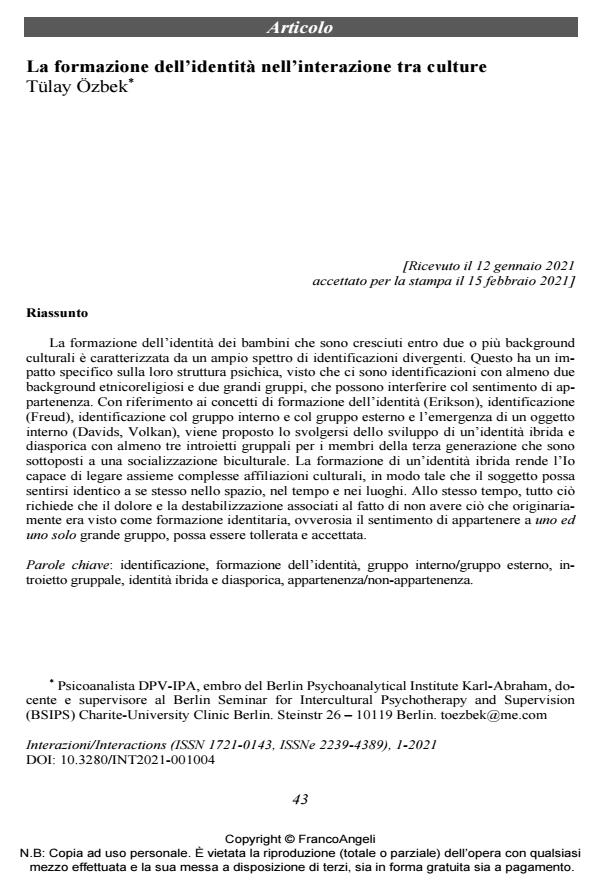The identity formation in the interplay between cultures
Journal title INTERAZIONI
Author/s Tülay Özbek
Publishing Year 2021 Issue 2021/1 Language Italian
Pages 16 P. 43-58 File size 197 KB
DOI 10.3280/INT2021-001004
DOI is like a bar code for intellectual property: to have more infomation
click here
Below, you can see the article first page
If you want to buy this article in PDF format, you can do it, following the instructions to buy download credits

FrancoAngeli is member of Publishers International Linking Association, Inc (PILA), a not-for-profit association which run the CrossRef service enabling links to and from online scholarly content.
The identity formation of children who are brought up within two or more cultural back-grounds is characterised by a wide range of divergent identifications. This has a specific im-pact on the characteristics of the psychic structure as there are identifications with at least two ethno-religious backgrounds/large groups, who may interfere with the feeling of belonging. On behalf of the concepts of identity formation (Erikson) identification (Freud), in-group/out-group identification and the emerge of an inner object (Davids, Volkan) the course of a di-asporic hybrid identity development with at least three group introjects is proposed for the members of the third generation who undergo bicultural socialisation. The hybrid identity for-mation will enable the ego to in linking together complex cultural affiliations in such a way that the subject feels identical with itself across space, time and place. At the same time this re-quires that the pain and destabilisation associated with the fact that one does not have what was originally seen as identity formation, i.e. a feeling of belonging to one large group, is bearable and accepted.
Keywords: Identification, identity formation, in-group/out-group, group introject, hybrid di-asporic identity, belonging/ non-belonging.
- Blum H.P. (1986). On Identification and its vicissitudes. International Journal of Psycho-Analysis, 67: 267-276.
- Davids F. (2011). Internal Racism. A Psychoanalytic Approach to Race and Difference. London: Palgrave Macmillan.
- Eickhoff F. (2011). Ein Plädoyer für das umstrittene Konzept der primären Identifizierung. Psyche – Zeitschrift für Psychoanalyse, 65, 1: 63-83.
- Etchegoyen H. (1985). Identification and its vicissitudes. International Journal of Psycho-Analysis, 66: 3-18.
- Erdheim M. (1992). Das Eigene und das Fremde. Über ethnische Identität. Psyche – Zeitschrift für Psychoanalyse, 46, 8: 730-742.
- Erikson E.H. (1956). The Problem of Ego Identity. Journal of the American Psychoanalytic Association, 4, 1: 56-121.
- Freud S. (1913). Totem e tabù. OSF, vol. 7. Torino: Bollati Boringhieri.
- Freud S. (1921). Psicologia delle masse e analisi dell’Io. OSF, vol. 9. Torino: Bollati Boringhieri.
- Freud S. (1923). L’Io e l’Es. OSF, vol. 9. Torino: Bollati Boringhieri.
- Freud S. (1925). Autobiografia. OSF, vol. 10. Torino: Bollati Boringhieri.
- Freud S. (1926). Discorso ai membri dell’Associazione B'Nai B'Rith. OSF, vol. 10. Torino: Bollati Boringhieri.
- Gezer Ö. (2013, November 4). Türkisiert [Turkeyfied]. Der Spiegel, 45. Retrieved January 9, 2016, from -- http://www.spiegel.de/spiegel/print/d-119402601.html
- Kaës R. (2009). Innere Gruppen und psychische Gruppalität: Entstehung und Hintergründe eines Konzepts. Psyche – Zeitschrift für Psychoanalyse, 63, 3: 281-305.
- Kazim H. (2010, December 24). Integrationsdebatte: Sarrazins Sünden ‒ böcke [Debate on integration: Sarrazin’s scapegoat]. Der Spiegel Online. Retrieved June 3, 2014, -- from http://www.spiegel.de/politik/deutsch-land/integrationsdebatte-sarrazins-suendenboecke-a-735774.html
- Langhoff S. (2008). -- http://www.bpb.de/gesellschaft/bildung/kulturelle-bildung/60135/interview-mit-shermin-langhoff?p=all. Zugriff 20.09.2019.
- Mayer R. (2005). Diaspora. Eine kritische Begriffsbestimmung. Bielefeld: transcript Verlag.
- Özbek T. (2012). Und es gibt sie doch die pakistanischen Cowboys ‒ Überlegungen zur hybriden Identitätsentwicklung. In Reiser-Mumme U., v. Tippelskich-Eissing D., Teising M., Walker C.E. (Hg.), Spaltung: Entwicklung und Stillstand. Frühjahrstagung der DPV. Frankfurt: Geber & Reusch.
- Özbek T. (2017). Living in Germany as a Kanak: Some Thoughts About Nonbelonging. Psychoanalytic Review, 104, 6: 707-721.
- Özbek T. (2020) (in press). The tale of those who went forth: On the inner experience of migration and forced migration. In White C., Klingenberg I. (Eds.), Migration and Inter-cultural Psychoanalysis: Unconscious Forces and Clinical Issues. London: Karnac Books.
- Simenauer E. (1985). Identification in the Theory and Technique of Psychoanalysis. Some Thoughts on its Farther Reaches and Functions. International Journal of Psycho-Analysis, 66: 171-184.
- Simsek S. (2012). Transkript eines Teils von Semiya Simseks Ansprache bei der Gedenkfeier zu den Opfern rechtsextremistischer Gewalt. Gamze Kubasik und Semiya Simsek erinnern an ihre ermordeten Väter/ -- www.youtube.com/watch?v=ra_NWRKRY-4–Zugriff 04.05.2012.
- Volkan V. (1999). Das Versagen der Diplomatie: Zur Psychoanalyse nationaler, ethnischer und religiöser Konflikte [The failure of diplomacy: The psycho-analysis of national, ethnic, and religious conflicts]. Gießen, Germany: Psychosozial, 2000.
- Volkan V. (2005). Blindes Vertrauen: Großgruppen und ihre Führer in Zeiten der Krise und des Terrors [Blind trust: Large groups and their leaders in times of crisis and terror]. Gießen, Germany: Psychosozial
Tülay Özbek, La formazione dell’identità nell’interazione tra culture in "INTERAZIONI" 1/2021, pp 43-58, DOI: 10.3280/INT2021-001004